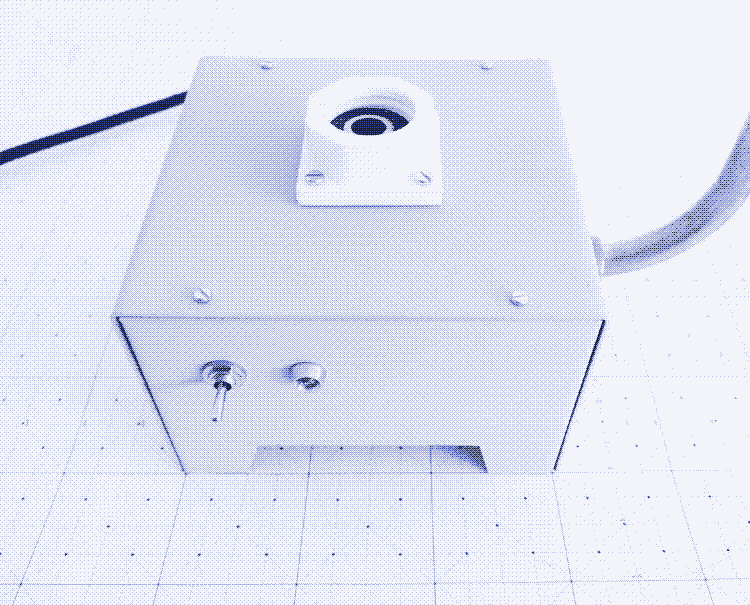
Reverting to traditional handicrafts is one way to sabotage the throwaway society. In this article, we discuss another possibility: the design of modular consumer products, whose parts and components could be re-used for the design of other products.
Initiatives like OpenStructures, Grid Beam, and Contraptor combine the modularity of systems like LEGO, Meccano and Erector with the collaborative power of digital success stories like Wikipedia, Linux or WordPress.
An economy based on the concept of re-use would not only bring important advantages in terms of sustainability, but would also save consumers money, speed up innovation, and take manufacturing out of the hands of multinationals.
Modular Products
A modular system unites the advantages of standardisation (as parts can be produced cheaply in large amounts) with the advantages of customisation (since a large diversity of unique objects can be made with relatively few parts).
Modularity can be found to a greater or lesser extent in many products (like bicycles and computers) and systems (like trains and logistics), but the best examples of modular systems are toys: LEGO, Meccano, and Erector (which is now the brand name of Meccano in the US).
LEGO, Meccano and Erector are composed of relatively few elementary building blocks, which can be used to build various objects. The parts can then be disassembled and re-used to build something completely different. Apart from the elementary buildings blocks, these manufacturers have produced many more specific building blocks, which are less versatile, but further increase customisation possibilities.
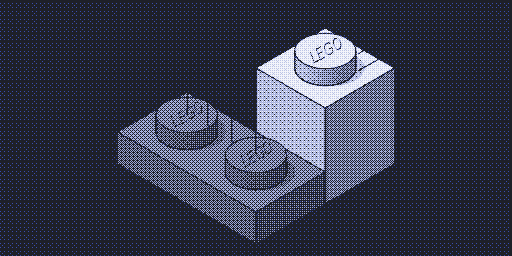
All the building blocks in a set of LEGO, Meccano or Erector fit together because they are designed according to a set of specific rules. The holes (Meccano and Erector) or studs (LEGO) have a precise diameter and are spaced apart at specific distances. In addition, the dimensions of the building blocks are precisely matched to each other.
The long lasting success of LEGO, Meccano and Erector (which appeared on the market in 1947, 1902 and 1911 respectively) is based on the fact that those rules have never changed. All new buildings blocks that were added in the course of the years are compatible with the existing ones. Today, kids can expand their collection of these toys with that of their parents or grandparents, and they are worth as much on the second hand market as they are worth new.
Grid Beam, Bit Beam, Open Beam, Maker Beam and Contraptor
The same principle could be applied to everyday objects, from coffeemakers to furniture, gadgets, cars and renewable energy systems. All you need is a standardisation in design. The design rules can be very simple, as is the case with Grid Beam. This modular construction system, which was developed in 1976, is based on beams with a simple geometry and a repetitive hole-pattern. The beams can be made of wood, aluminium, steel, or any other material.
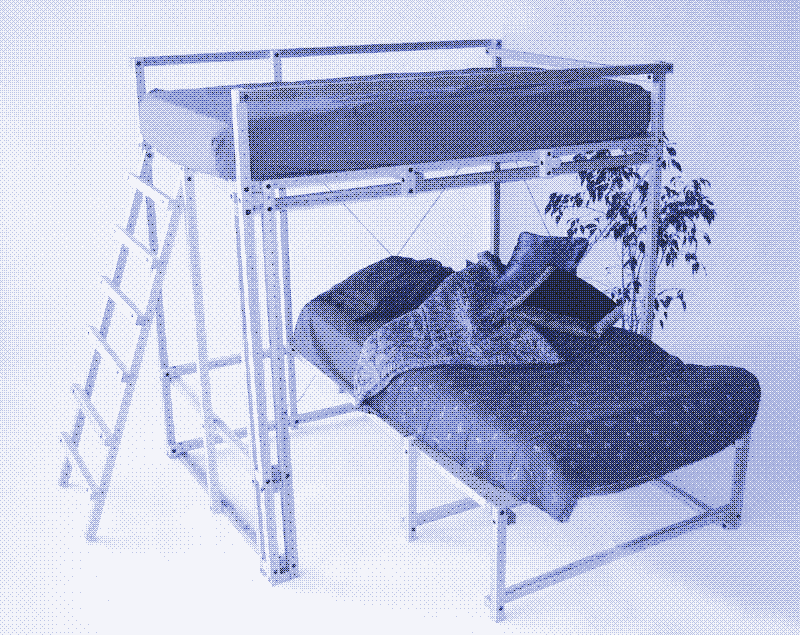
In spite of the simplicity of the design, a great variety of objects can be constructed. Grid Beam has been used to make all kinds of furniture, greenhouses, constructions for workshops and industrial processes, windmills, wheelbarrows, agricultural machinery, vehicles, sheds and buildings (a book about the system was published in 2009, and can be found online). Grid Beam was inspired by a system envisioned by Ken Isaacs in the 1950s, Living Structures, which used similar beams but contained only a few holes.
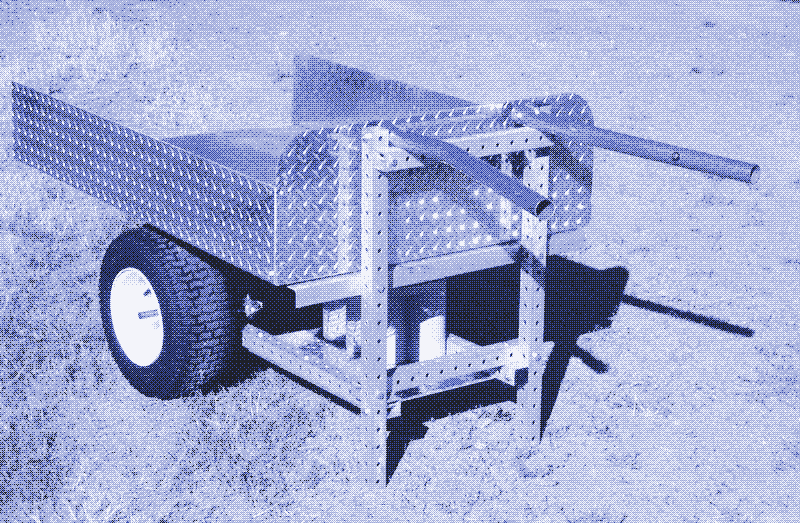
In recent years, several systems have appeared that use a very similar set of rules, based on a repetitive hole pattern. Bit Beam is basically a scaled-down version of Grid Beam, aimed at building smaller structures in balsa-wood, like a laptop stand or a prototype device. Contraptor uses a similar approach, but is aimed at providing structural metal frames for DIY 3D-printers, milling machines, or robotics. OpenBeam and MakerBeam are also modular construction systems based on very simple rules. These are not based on a hole-pattern, but use T-slot aluminium profiles. Makeblock combines both approaches and includes electronic modules.

Most of these construction systems are limited to the design of frameworks. There is one system, however, that offers much more possibilities, because it is based on a more sophisticated set of rules: OpenStructures. The project was kicked off in Brussels in 2007. Unlike all the projects above, OpenStructures is still in an experimental phase. However, it is interesting enough to look at in more detail, because it best shows where modular construction systems may be headed in the future.
OpenStructures
The first basic rule of OpenStructures is shared with Grid Beam and similar systems: all parts are connected to each other in such a way that they can be easily disassembled, using bolts and screws rather than nails or glue. However, the OpenStructures design “language” is different: it is based on the OS Grid, which is built around a square of 4x4 cm and is scalable. The squares can be further subdivided or put together to form larger squares, without losing inter-compatibility. The illustration below shows nine complete squares of each 4x4 cm put together.
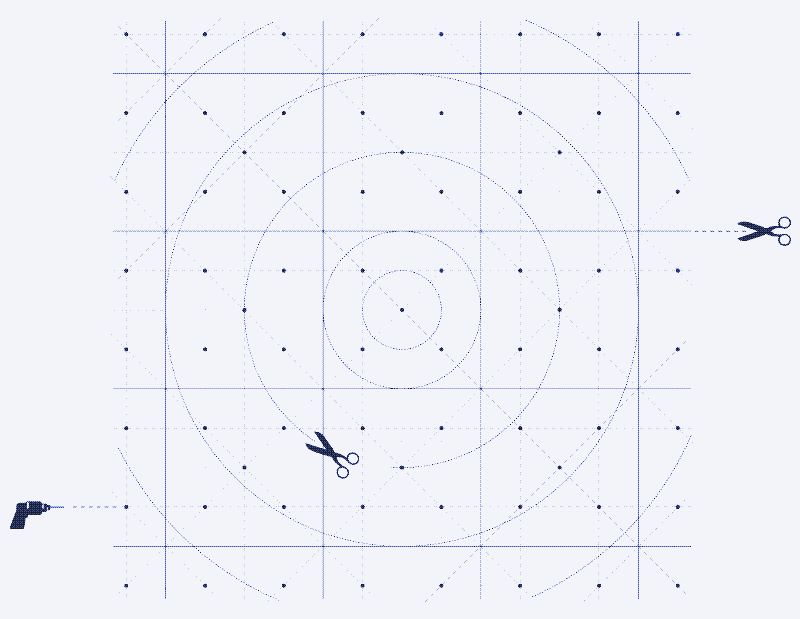
The borders of the squares mark the cutting lines (which define the dimensions of square parts), the diagonals determine the assembly points, and the circles define the common diameters. As is the case with LEGO, any modular part has to comply with at least one of these conditions in order to be compatible with other parts. Either the dimensions have to correspond with the horizontal and vertical lines, or the assembly points should be spaced according to the grid, or the diameters should be similar. Below is a part that fulfills two of three conditions.

While this set of rules is more sophisticated than that of the Grid Beam system, complicated it is not. Nevertheless, it allows for the design of a much larger variety of objects, not just square or rectangular frames. Over the course of five years, OpenStructures has yielded objects ranging from household devices to cargo bicycles, suitcases and furniture.
Open versus Closed Modular Systems
In spite of the similarities, there is one fundamental difference between modular construction systems such as OpenStructures, Grid Beam and Contraptor, and modular toys such as LEGO, Meccano and Erector. The first group consists of “open” modular systems, where everyone is free to design and produce parts, while the second consists of “closed” modular systems, where all parts are designed and produced by one manufacturer. Closed modular systems produce uniform parts. For instance, all LEGO building blocks are made of plastic. LEGO does not produce building blocks made of wood, aluminium, glass or ceramics. There is a limited range of colours. And because LEGO is a closed system, nobody else is allowed to produce LEGO pieces.

There exist modular construction systems that operate according to the same principles, like the T-profiles made by 80/20 inc. However, in the modular construction systems that we have introduced above, everyone is allowed to design and produce parts, as long as these parts are compatible with the basic set of rules. We find the same approach with open software, like Linux (an operating system), OpenOffice (office software) or WordPress (a blogging platform). The computer code for these systems is being written by a large amount of people, who all build a part of something larger. Because all participants stick to a basic set of rules, a great amount of people can, independently of one another, add parts that are inter-compatible.
Consumer products based on an open modular system can foster rapid innovation, without the drawback of wasting energy and materials
An open modular system has many advantages over a closed modular system. Since anyone can design parts in an open system, it generates a much larger diversity of parts: they can be made in different colours and materials, and none of the producers can set a fixed price for all consumers. And because many designers constantly review, adapt and improve each others’ work, innovation is accelerated. All open software systems described above are arguably better than their closed counterparts, and some of them have become more successful. A closed modular system only has one advantage: the one who holds the copyright makes a lot of money.
Sustainable Consumer Goods
Modular construction systems encourage the re-use of physical parts, and thus form a sustainable alternative to our present-day system of producing consumer items. Most products that we buy end up in landfills or incinerators within a couple of years, at most. This is because the majority of manufacturers encourages consumers to replace their products as quickly as possible, either by designing objects that break down easily, or by introducing new generations of products which make the former generation of products obsolete. This approach not only generates a massive pile of waste, it squanders an equally massive amount of energy and raw materials.

Consumer products based on an open modular system can foster rapid innovation, without the drawback of wasting energy and materials. The parts of an obsolete generation of products can be used to design the next generation, or something completely different. Furthermore, modular objects have built-in repairability.
Open modular construction systems could greatly speed up the diffusion of low-technologies, such as pedal-powered machines, solar thermal collectors, velomobiles or cargo cycles. Building a windmill or a cargo bike goes much faster when using modular parts than when using carpentry or welding, and there is no need for expensive tools or special skills. Mistakes can be easily corrected – just unscrew the bolts and start again. It would also be interesting to see modular parts combined with an open hardware project such as the Global Village Construction Set, which generates many interesting designs but makes limited use of modularity.
Circulation of Parts
“While eBay provides a circulation of objects, and cradle-to-cradle provides a circulation of materials, modular construction systems provide a circulation of parts and components”, says Thomas Lommée, the creator of OpenStructures. “Our ambition is to create puzzles instead of static objects. The system should generate objects of which it is not entirely clear anymore who designed them. An object evolves as it is taken in hands by more designers.”

The kitchen appliances that were designed in the context of the project are good examples. A couple of parts were initially made for a coffee grinder, were then used, together with new parts, by another designer to build a coffeemaker. This appliance was then further developed into a water purification device by a third designer. The plastic bottle that served as a water container was replaced by a cut through glass bottle containing a clay filter. Thomas Lommée: “By adding or removing components, or by using them in a different manner, what you get is a family of objects”.
Cargo Cycle
Another prototype that originated from the project, is a cargo cycle. The rear is a sawed through frame of a standard bicycle, the end of which is compatible with the OS Grid. This means that the front of the cycle can be built up in a modular way. Designer Jo Van Bostraeten used this opportunity to design both a cargo bicycle and a cargo tricycle (the latter is carrying a 3D-printer), and it doesn’t end there. Together with Lommée, he also constructed a modular motor block. The unit consists of an electric motor and wheels, on top of which a similar unit can be placed that holds a battery. Since the units are compatible with the OS Grid, they can be coupled to the front of the cargo cycle, resulting in a completely modular motorised cargo vehicle.
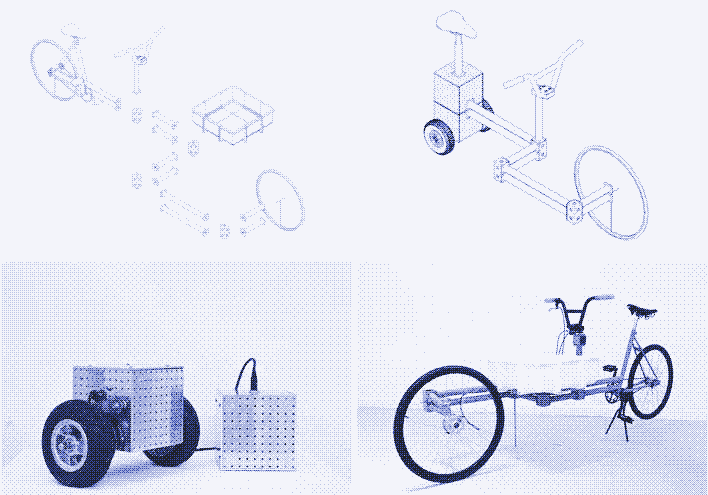
The latest “family” of objects to come out of the project is aimed at children. It is noteworthy that this collection arose from one component of the cargo cycle — the container. It is built up from modular parts that can be bolted together, and can thus be combined in different ways. A couple of designers got started with those parts, resulting in (among other things) a sled, a seat, a toy excavator, and a swing. When the child becomes an adolescent, the parts can be used to make a suitcase or a tool box, or become part of a cargo cycle that could make him or her some pocket money.
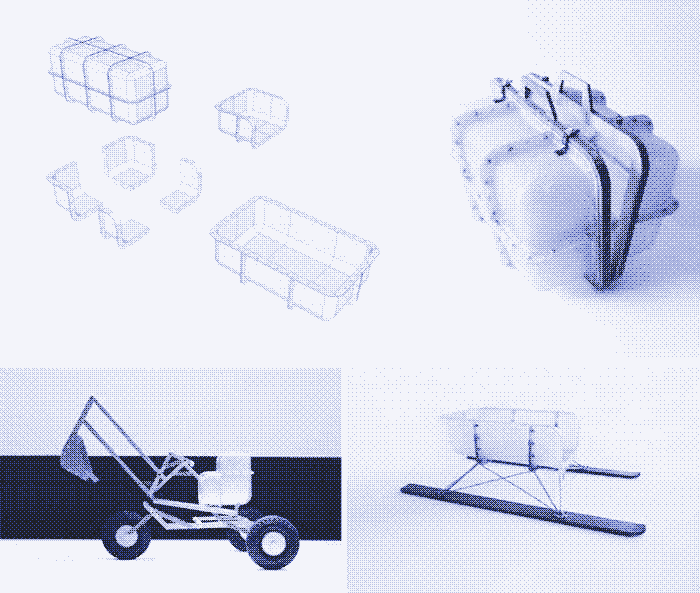
More interesting than the objects themselves, is their user support system. Grid Beam is obviously a product from the pre-internet age. Those who want to copy a design are encouraged to look at a picture of someone else’s creation and “count the holes”. OpenStructures, on the other hand, leans heavily on online user support. The re-use of parts is being facilitated by an online database that can be used in three ways.
A Modular Database
First, you can request an overview of all objects that were designed based on the OS grid. The webpage for each object then shows you the parts and components from which it is made. Second, you can request an overview of all parts that were designed based on the OS grid. The webpage for each of these shows you which components and objects they could serve. Third, you can request an overview of all components. The webpage for each component shows you their parts and the objects they can be used for.
Open modular construction does not mean that everyone should make their own consumer products
The webpage for each part, component and object also gives additional information: the dimensions, the materials, the designer’s name, the licence and the order information. To add to this, all parts and components receive a serial number. This means that after a modular object is taken apart, the serial number of each part and component can be entered into the database to see what else can be made with it. Missing parts can be obtained via the database: either by ordering them online, by finding the address of a shop where they sell them, or by downloading the digital design and making them.
Not Everyone is a Designer
Open modular construction does not mean that everyone should make their own consumer products. An object like a coffee maker or a workbench could be obtained in at least three ways. Firstly, the consumer can download the digital design and then assemble the object with parts that he or she buys, re-uses, or makes using a 3D-printer or laser cutter, whether at home or at a fab lab or tech shop. It can also happen in a more low-tech fashion, as is the case with Grid Beam: the consumer buys wood or metal beams, and drills the holes himself.
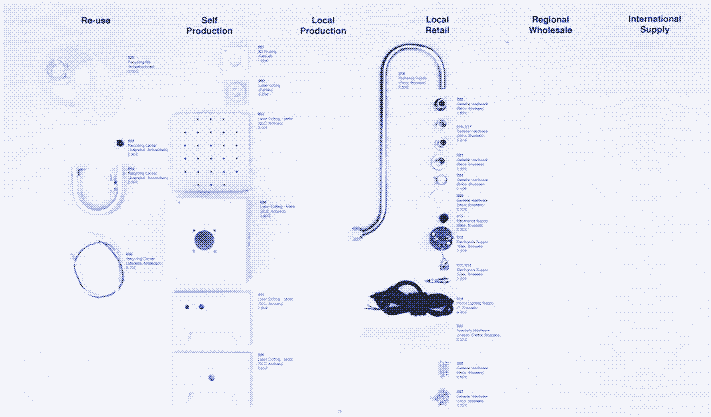
A second option is that a company buys the license of the design (if it is not free) and converts it into a building kit, comparable to a kit from LEGO, Meccano or Erector. In this case, the consumer would not have to search for the parts himself, but he still assembles the product himself, just like he would assemble a piece of furniture by IKEA. Similarly, a company could offer a more general building kit, which can be used to make whatever one would like, similar to a box of basic LEGO bricks. Bit Beam, Contraptor, Open Beam, Maker Beam and, recently, Grid Beam offer one or both of these options.
The third possibility is that a manufacturer places the object on the market as a finished, assembled product. The coffee maker or the workbench would then be sold and bought just as any other product today, but it can be disassembled after use, and its parts can be re-used for other objects.
Economic Model: who Produces the Parts?
While the design process behind OpenStructures and other open modular construction systems is identical to that of digital products such as Wikipedia, Linux or WordPress, there is also a fundamental difference. Computer code and digital text accumulate without any material costs. This is not the case with objects. This makes open modular hardware less easy, but it also creates economic opportunities. It’s hard to make money with open software or online writing. However, in the case of an open modular system for objects, someone has to provide the materials.
It is also important that the parts are produced by as many manufacturers as possible, so that they are available worldwide. Otherwhise, the shipping costs can be so high that a modular object becomes too expensive.
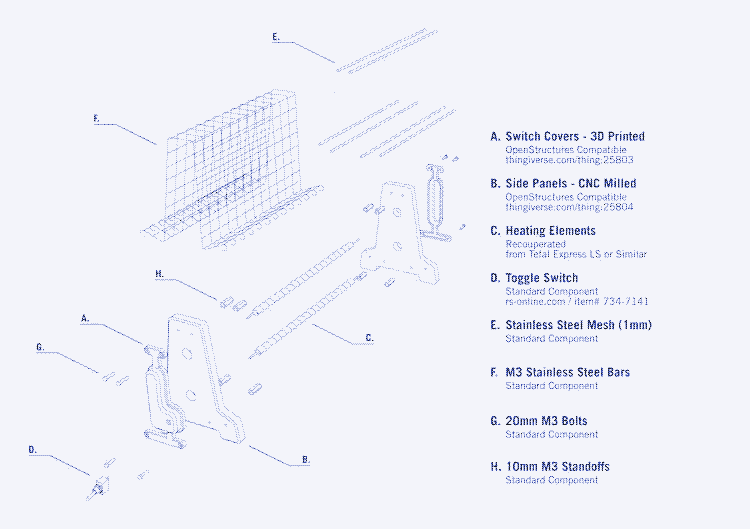
There are many opportunities to make money with an open modular construction model. A manufacturer can choose to produce a part in which they sees economic potential. Another manufacturer can choose to sell a building kit or a finished product of a design they think will sell. A designer can make money by uploading a design that might be free to download for personal use, but not for commercial use. A manufacturer that wants to commercialise this design, can then buy the licence from the designer.
Craftsmen can focus on the design of exclusive, handmade parts in special materials, which are compatible with popular mass produced items. Others can start a fab lab or a tech shop where people can build their own modular objects for a monthly fee. In short, an open modular construction system offers economic opportunities for everybody.
Collaborative Economy
“It is not our ambition to build a gigantic factory that produces all possible parts”, Lommée notes. “OpenStructures should not become a modular IKEA. Our ambition is the creation of a collective economic system, where one producer benefits from the production of another producer. Because parts which are made by one, can be used by another. What we would like to see, are streets full of little shops where everybody generates their own little part of a larger system, a collaborative economy where small, self-employed producers have their place. Not one big player that makes everything. The social dimension is very important.”
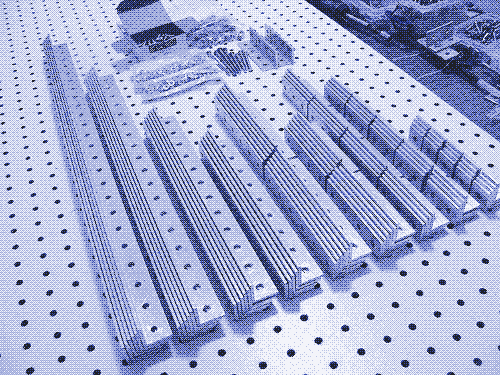
“If IKEA wants to sell a product that is compatible with our system, then that’s fine with me. But the system can only work if it remains open. The larger it becomes, the easier it is for a small company or a craftsman to be a part of it. The ambition is to start a universal, collaborative puzzle that allows the widest possible range of people – from craftsmen to multinationals — to design, build and exchange the widest possible range of modular parts and components.”
Organising Re-use
Apart from a design language (the OS grid) and an online database, OpenStructures also has set up a prototype of a warehouse in Brussels. This kind of place should become the hub for the organisation of the re-use of parts and components. Think a fab lab or tech shop, but then combined with the storage of modular parts. If a modular product is no longer needed, and the owner does not feel like using the parts to build something new, he or she brings it to one of these places, where it is taken apart, and its parts are stored.
An open modular construction system offers economic opportunities for everybody
Other people could come to this place to buy parts or to use them on site to build something new. As Lommée says: “Not everyone has to make their own products, but after its useful life, a modular product always comes into the hands of a group of people who like to make things.”
Compatibility between Open Modular Systems
While it is still in an experimental phase, OpenStructures is by far the most ambitious and complete open modular system designed to date. However, being a European project, it follows the international metric system, while the much older Grid Beam follows the imperial system. The systems are not compatible. With more and more open modular systems appearing, would it not be important to provide inter-compatibility between them?
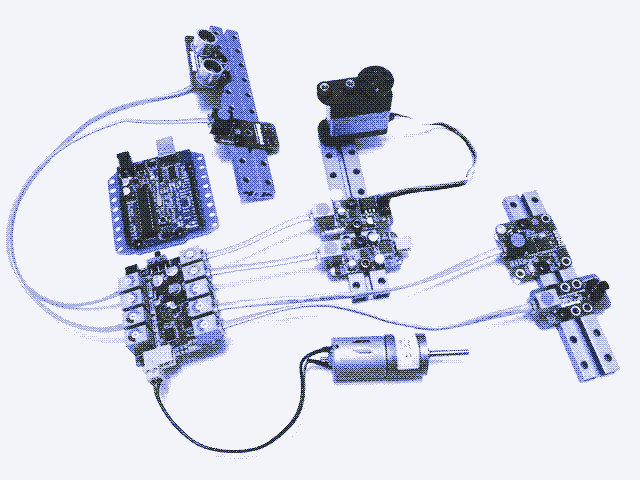
Lommée doesn’t think so: “Most of these systems are designed for different applications. For instance, Contraptor aims at precision, because the parts are used to build robots and other sophisticated machines. Esthetics are clearly not important. I am a designer, so what interests me especially is whether or not a modular system can generate beautiful objects, things you would want to put in your interior. There is also Wikispeed, for instance, which concentrates on the development of a modular car. Arduino is aimed at electronics. I don’t think that all of these modular systems have to be compatible with each other because the applications are very different.”
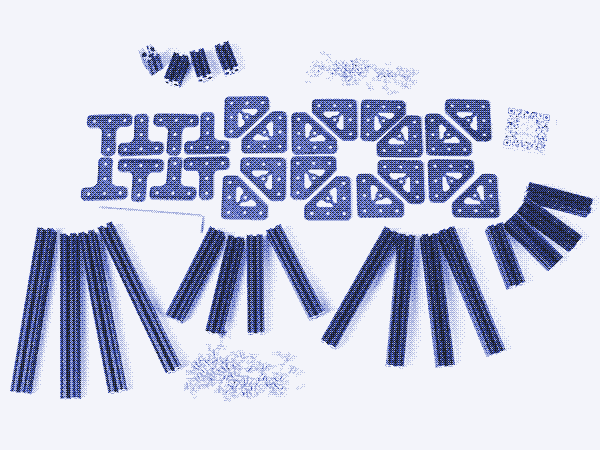
He goes on to explain why he chose the metric system. “I have been doubting a lot about this. But in the end I decided that the metric system is easier to work with. And I think the world is big enough for two systems — just look at the variety of energy standards which are in use. Somebody has developed a European version of Contraptor, based on the metric system and compatible with the OS grid. And it is always possible to design a coupling between two systems, so that they can be used together. On the other hand, we live in a networked world where everything is connected and copied. This often means that when standards compete, only one survives. And this is not necessarily the best one. I’ll keep my fingers crossed.”
Reactions
To make a comment, please send an e-mail to solar (at) lowtechmagazine (dot) com. Your e-mail address is not used for other purposes, and will be deleted after the comment is published. If you don’t want your real name to be published, sign the e-mail with the name you want to appear.
Reactions
Abhijit
Hi,
What a timely post! As economic and ecological challenges abound, open hardware can play a big role in solving so many problems.
Just recently read about Makeblock project http://www.makeblock.cc/ from Shenzhen, China who are making aluminum extruded based platform for construction of machine tools and robots. This will enable economical machine usage.
Love your blog.
Kris De Decker
Alex
It seems like you have missed a part of the article. What you are talking about is dealt with under the header “Not everyone is a designer”.
Paul
When I look at OpenStructures from the point of view of someone building at home, creating the building materials from what is available today, it looks like there is a lot of unnecessary hole drilling.
However if materials are manufactured, that additional effort and cost may not be very expensive. Once drilled, the part can be reused, which is very good.
The system does not look like it can be used to build weather-proof or waterproof structures. No glues, tapes or sealants means that the constructed items need to be used indoors, or they need to be made of weather proof materials.
john
Thanks the one I was looking for was on that page- the compilation by Alex Weir.Thanks so much it’s a fantastic source of information. I really enjoyed the article on the Chinese wheelbarrow a few issues ago and I thought either you(KD) or Lowtech magazine readers might be interested in a book By Daniel Sheets Dye on Chinese lattice window design. There are 100’s of intricate designs. Check it out!
Jakob
Thanks for the great overview. I think compatibility is crucial, so I collected some dimensions. One should consider reusing the 8mm LEGO grid which is also used by Makeblock and Gridbeam with standard M4 screws. LEGO is also used in Robotics and one can easily switch to Open Hardware when using the 8mm grid and M4 screw standard. The base 4×4cm square of OpenStructure fits at least to some degree (4cm = 5x8mm) but I am not sure about their propsal to divide each square and where to put assembly points. MakerBeam is 10x10mm with a 3mm gap for M3 screws and OpenBeam is 15x15mm with a 3mm gap and a smaller gap (1.6mm?). For small electrical circuits one should also be aware of the standard 0.1 inch / 2.54mm grid and for large constructions one should know pallet and ISO container sizes.
Tim Collins
The danger is that this technology ( or non-technology) is open to a large company’s gaining control of the manufacturing processes of the standard components and creating a monopoly over production of ANYTHING. One has to look at this with the eye of a business baron who doesn’t have the interests of the whole in mind. That is what he’s programmed to do.
Ed Norris
Golan Levin and his team put together a system to connect 10 different constructor toys (Lego, Duplo, Krinkle, Tinkertoys, etc), which is a way to open those closed systems.
http://www.notcot.com/archives/2012/03/free-universal-construction-ki.php
Of course, no one can sell these adapters for legal reasons but you can 3d-print them yourself.
Steve Hinton
Great post! I envisioned something like this for the Inventing for the sustainable plaet experiment where everything was made of modules, and brands were design only companies with licensed workshops making adn distributing their goods made of standard and recycled parts. Workshops did not sell goods but they sold the function and repairs were included.
http://avbp.net/docs/newsletter_1_4_module.pdf
mathew
As a USAian who grew up using both imperial and metric units, I love how metric handles scale transitions better than imperial (going from inches to feet, etc), but one thing has always bugged me about it: base 10 sucks. Inches use of base 12 encourages elegant ratios (1/3rds, for instance), and the use of base 2 subdivisions is extremely useful while working.
By starting with a 4x4cm grid, Open Structures is solving one of my problems with metric. I hope it can gain some traction here in the ‘states and we can finally put our clumsy non-standard measurement system behind us, while maintaining some of its better points.
JohnMc
This is an excellent topic and I have been a big user of 80/20 components. The design flexibility of the system makes it quite easy to use. I would also point out that one can impress the OpenSystem methodology to an extent on 80/20 if one follows a few rules.
I would point out one other thing that has made Linux and its sister projects a success is legality. One could certainly have an open system but be legally hampered if the designer/developer/mfr places legal restrictions in your way. It would a near critical requirement that any development of a open systems manufacturer have a clear legal framework that is open source-like in understanding.
SpaceHobo
“He goes on to explain why he chose the metric system” should have been followed by “Well, there are only three countries that don’t use it”
What an odd perspective, having to justify the dominant system of measurement worldwide!
CubeSpawn
In the same vein, You may also be interested in CubeSpawn, wich will soon be able to make any of the other systems mentioned in this article
http://www.cubespawn.com
Christopher
Frequent self-builders will no doubt gradually amass significant stockpiles of spare parts to facilitate efficient construction. If there’s any parallel to my childhood LEGO collection (and there certainly is) my ideal spares pile will have significantly more parts than are used in all of my existing constructions. And even then, each new project will have me wanting at least one new part. Not so bad if we’re talking electronics and small appliances, but could be seen as wasteful (both materials and space) for larger systems. Trying to force a solution from a limited spares collection, however, will no doubt lead to innovative and/or whimsical results.
I like the parts warehouse idea, especially if stored resources are available for small, personal purchases. I’d also like to see a less-centralized approach that helps people looking to buy or unload spare parts find each other directly. We would also need to figure out how best to reintroduce modified parts to the re-use cycle. (e.g. cut to a non-standard lengths, covered in thick paint, etc.)
As long as things stay open, I’m sure redistribution will become very efficient, taking many different paths.
Alex
No, I think you missed the gestalt of my post. I didn’t overlook what you said, I just think it’s incredibly naive.
In scenarios 1 and 2, people still end up “manufacturing” their own stuff at home or becoming systems integrators in their so-called free time. Most people don’t even have time to clean the kitchen.
And scenario 3 simply describes what already happens: manufactures make products, sometimes using licensed designs created by someone else. Sometimes products get reused, refurbished, or repurposed. Sometimes they end up in a landfill.
I admire the effort and the intent but this is just the Modernist project all over again, with some new tech thrown in. The article makes reference to projects from the 1950s and 1970s. The ideas have already been tried, why didn’t they work out?
Because then, as now, most people would rather buy stuff and get on with their daily lives, and when that stuff breaks, they’d rather pay an expert to fix it, instead of having to understand how every single object in their home works.
And because not all multinational corporations are evil machines trying to sell people stuff they don’t need. Instead of thinking of a manufacturer as an evil empire bent on engendering a “throwaway society,” think of them as teams of really smart people trying to solve technical and logistical problems so that you don’t have to.
Alex @ Off Grid
I think the beauty of this is that it is naturally resistant to monopolization. For example, it could be argued that the metric system itself is a form of modular architecture - taken for granted yet used by many. The benefits of conforming to such an architecture are immediate and obvious. If someone had attempted to patent the metric system, it would not have flourished in the same way. These ideas are an extension of such open systems to the hardware realm.
Also, the use of such a system does not prevent specialization, it both encourages it and enables participation in it by all.
Another benefit is that there is little waste in such a system. Things would be more easily repaired - and dismantled objects have value in that they can always be used to make other objects - therefore very little is discarded.
Paul
@Alex, I think the problem is with the current system is that it is on the verge of breaking down. Landfills are filling up, “low hanging fruit” resources are exploited, energy sources will be forced to go up in price due to environmental degradation.
These issues (and a host of others) will force a price on inefficiency and detrimental practices. Those prices will pass on to the consumer, who will look for alternatives.
Therefore it seems that this is an idea “just” before its time.
Usman A. Ghani
Excellent coverage and eye-opening as to why we need this in early ages. Thank God my parents got me Meccanos and encouraged assembly and disassemble to make other “products.” Future engineers and R&D folks should read this article carefully.
Dairokkan
Well, that is interesting idea but I don’t think that it will work well. Simply because no one make exact plans when building something. I’m not talking about electronics, where you have to have scheme and calculated resistors and capacitors, but about making things like garden furniture etc. When I was small, when we were making something with my grandpa we usually ended with something what was not in plans. For example we tried wind power plant. Well it probably lit light bulb only once, we had plans but ended with something totally different.
Another problem is that people will want, every time, something that don’t look like runaway mechano.
Nick Grigoryev
Hello world :)
Let me add my 10 cents: please check out my open-source educational robotic kit, which anybody can download, 3D-print and assemble - Neurobot.
http://www.thingiverse.com/thing:1378603
It runs Arduino, Raspberry Pi, Linux and ROS (Robot Operating System). All these components are open-source hardware and software.
Have fun :)
Nick
Rod
One thing people might consider is getting away from consumer line products and going commercial on some items. For example commercial coffee makers are all close to the same design, made to be easily repaired, with parts readily available and will last the average family a lifetime. This is a good idea also for people not inclined to building there own products. This is close to what the author describes.
Ramani Sankaran
Excellent narration.Animal power can be added. I have developed a Non Electric Manually Operated Washing machine for clothes. You can see this performing in a village by opening my website
www.simplsolutions7.com
Please let me know if you need a write up about my innovation for which patent is pending.
Ramani.S. Dr
Anton
Hi,
I would like to know if there is higher resolution image of the parts for making a coffeemaker. I would like to make one but I can’t see what parts I need to gather.
Thank you,
Anton
Paul
Every time I get reminded of and look at OpenStructures, it gets worse and worse. Their website sucks, their licensing terms are not actually open, and now I can’t even find the grid specs document.